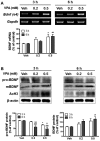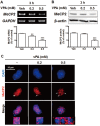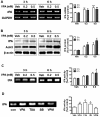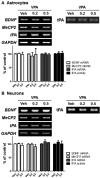Dual mechanisms for the regulation of brain-derived neurotrophic factor by valproic acid in neural progenitor cells
- PMID: 30402028
- PMCID: PMC6205935
- DOI: 10.4196/kjpp.2018.22.6.679
Dual mechanisms for the regulation of brain-derived neurotrophic factor by valproic acid in neural progenitor cells
Erratum in
-
Corrigendum to: Dual mechanisms for the regulation of brain-derived neurotrophic factor by valproic acid in neural progenitor cells.Korean J Physiol Pharmacol. 2019 Jan;23(1):91. doi: 10.4196/kjpp.2019.23.1.91. Epub 2018 Dec 26. Korean J Physiol Pharmacol. 2019. PMID: 30627015 Free PMC article.
Abstract
Autism spectrum disorders (ASDs) are neurodevelopmental disorders that share behavioral features, the results of numerous studies have suggested that the underlying causes of ASDs are multifactorial. Behavioral and/or neurobiological analyses of ASDs have been performed extensively using a valid model of prenatal exposure to valproic acid (VPA). Abnormal synapse formation resulting from altered neurite outgrowth in neural progenitor cells (NPCs) during embryonic brain development has been observed in both the VPA model and ASD subjects. Although several mechanisms have been suggested, the actual mechanism underlying enhanced neurite outgrowth remains unclear. In this study, we found that VPA enhanced the expression of brain-derived neurotrophic factor (BDNF), particularly mature BDNF (mBDNF), through dual mechanisms. VPA increased the mRNA and protein expression of BDNF by suppressing the nuclear expression of methyl-CpG-binding protein 2 (MeCP2), which is a transcriptional repressor of BDNF. In addition, VPA promoted the expression and activity of the tissue plasminogen activator (tPA), which induces BDNF maturation through proteolytic cleavage. Trichostatin A and sodium butyrate also enhanced tPA activity, but tPA activity was not induced by valpromide, which is a VPA analog that does not induce histone acetylation, indicating that histone acetylation activity was required for tPA regulation. VPA-mediated regulation of BDNF, MeCP2, and tPA was not observed in astrocytes or neurons. Therefore, these results suggested that VPA-induced mBDNF upregulation was associated with the dysregulation of MeCP2 and tPA in developing cortical NPCs.
Keywords: Brain-derived neurotrophic factor; Methyl-CpG-binding protein 2; Tissue plasminogen activator; Valproic acid.
Conflict of interest statement
CONFLICTS OF INTEREST: The authors declare no conflicts of interest.
Figures




Similar articles
-
Sexually Dimorphic Epigenetic Regulation of Brain-Derived Neurotrophic Factor in Fetal Brain in the Valproic Acid Model of Autism Spectrum Disorder.Dev Neurosci. 2017;39(6):507-518. doi: 10.1159/000481134. Epub 2017 Oct 27. Dev Neurosci. 2017. PMID: 29073621 Free PMC article.
-
Valproic acid induces astrocyte-dependent neurite outgrowth from cultured rat primary cortical neuron via modulation of tPA/PAI-1 activity.Glia. 2013 May;61(5):694-709. doi: 10.1002/glia.22463. Epub 2013 Feb 4. Glia. 2013. PMID: 23378038
-
MeCP2 Modulates Sex Differences in the Postsynaptic Development of the Valproate Animal Model of Autism.Mol Neurobiol. 2016 Jan;53(1):40-56. doi: 10.1007/s12035-014-8987-z. Epub 2014 Nov 18. Mol Neurobiol. 2016. PMID: 25404090
-
Epigenetic landscape of amphetamine and methamphetamine addiction in rodents.Epigenetics. 2015;10(7):574-80. doi: 10.1080/15592294.2015.1055441. Epigenetics. 2015. PMID: 26023847 Free PMC article. Review.
-
Transcriptional Regulation of Brain-Derived Neurotrophic Factor (BDNF) by Methyl CpG Binding Protein 2 (MeCP2): a Novel Mechanism for Re-Myelination and/or Myelin Repair Involved in the Treatment of Multiple Sclerosis (MS).Mol Neurobiol. 2016 Mar;53(2):1092-1107. doi: 10.1007/s12035-014-9074-1. Epub 2015 Jan 13. Mol Neurobiol. 2016. PMID: 25579386 Review.
Cited by
-
Efficacy and mechanisms of Dingxian pill combined with valproic acid on pentylenetetrazol-induced chronic epilepsy in rats.J Tradit Chin Med. 2023 Apr;43(2):286-294. doi: 10.19852/j.cnki.jtcm.20220928.002. J Tradit Chin Med. 2023. PMID: 36994516 Free PMC article.
-
Impaired Aggrephagy, Interrupted Vesicular Trafficking, and Cellular Stress, Lead to Protein Aggregation, and Synaptic Dysfunction in Cerebellum of Children and Adults with Idiopathic Autism.Cerebellum. 2025 Aug 8;24(5):140. doi: 10.1007/s12311-025-01880-5. Cerebellum. 2025. PMID: 40779003 Free PMC article.
-
Adolescent treadmill exercise enhances hippocampal brain-derived neurotrophic factor (BDNF) expression and improves cognition in autism-modeled rats.Physiol Behav. 2024 Oct 1;284:114638. doi: 10.1016/j.physbeh.2024.114638. Epub 2024 Jul 14. Physiol Behav. 2024. PMID: 39004196
-
Combining in vitro assays and mathematical modelling to study developmental neurotoxicity induced by chemical mixtures.Reprod Toxicol. 2021 Oct;105:101-119. doi: 10.1016/j.reprotox.2021.08.007. Epub 2021 Aug 26. Reprod Toxicol. 2021. PMID: 34455033 Free PMC article.
-
Genetic Causes and Modifiers of Autism Spectrum Disorder.Front Cell Neurosci. 2019 Aug 20;13:385. doi: 10.3389/fncel.2019.00385. eCollection 2019. Front Cell Neurosci. 2019. PMID: 31481879 Free PMC article. Review.
References
-
- Geschwind DH, Levitt P. Autism spectrum disorders: developmental disconnection syndromes. Curr Opin Neurobiol. 2007;17:103–111. - PubMed
-
- Persico AM, Bourgeron T. Searching for ways out of the autism maze: genetic, epigenetic and environmental clues. Trends Neurosci. 2006;29:349–358. - PubMed
-
- Eadie MJ. Antiepileptic drugs as human teratogens. Expert Opin Drug Saf. 2008;7:195–209. - PubMed
-
- Rasalam AD, Hailey H, Williams JH, Moore SJ, Turnpenny PD, Lloyd DJ, Dean JC. Characteristics of fetal anticonvulsant syndrome associated autistic disorder. Dev Med Child Neurol. 2005;47:551–555. - PubMed
-
- Schneider T, Przewłocki R. Behavioral alterations in rats prenatally exposed to valproic acid: animal model of autism. Neuropsychopharmacology. 2005;30:80–89. - PubMed

